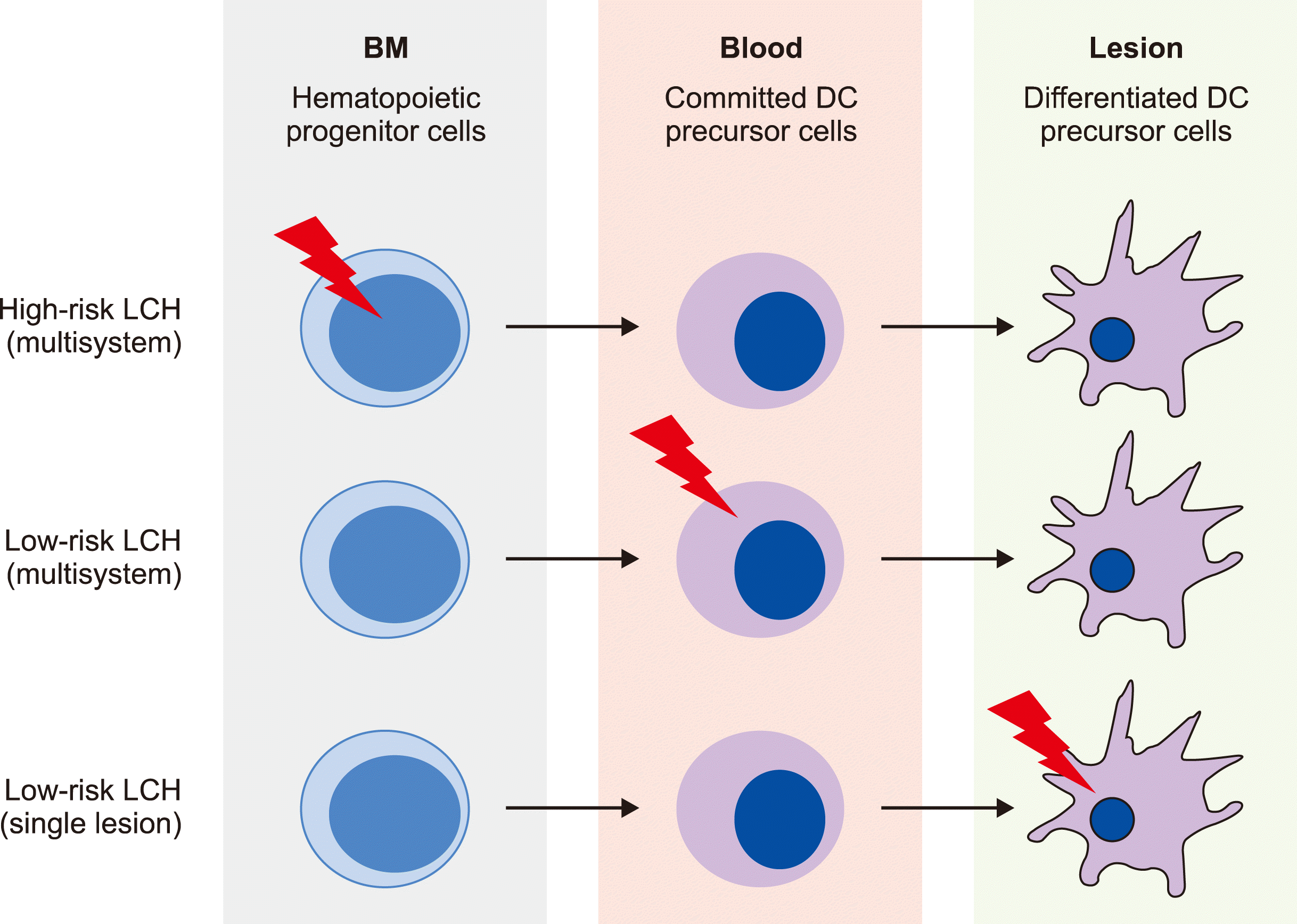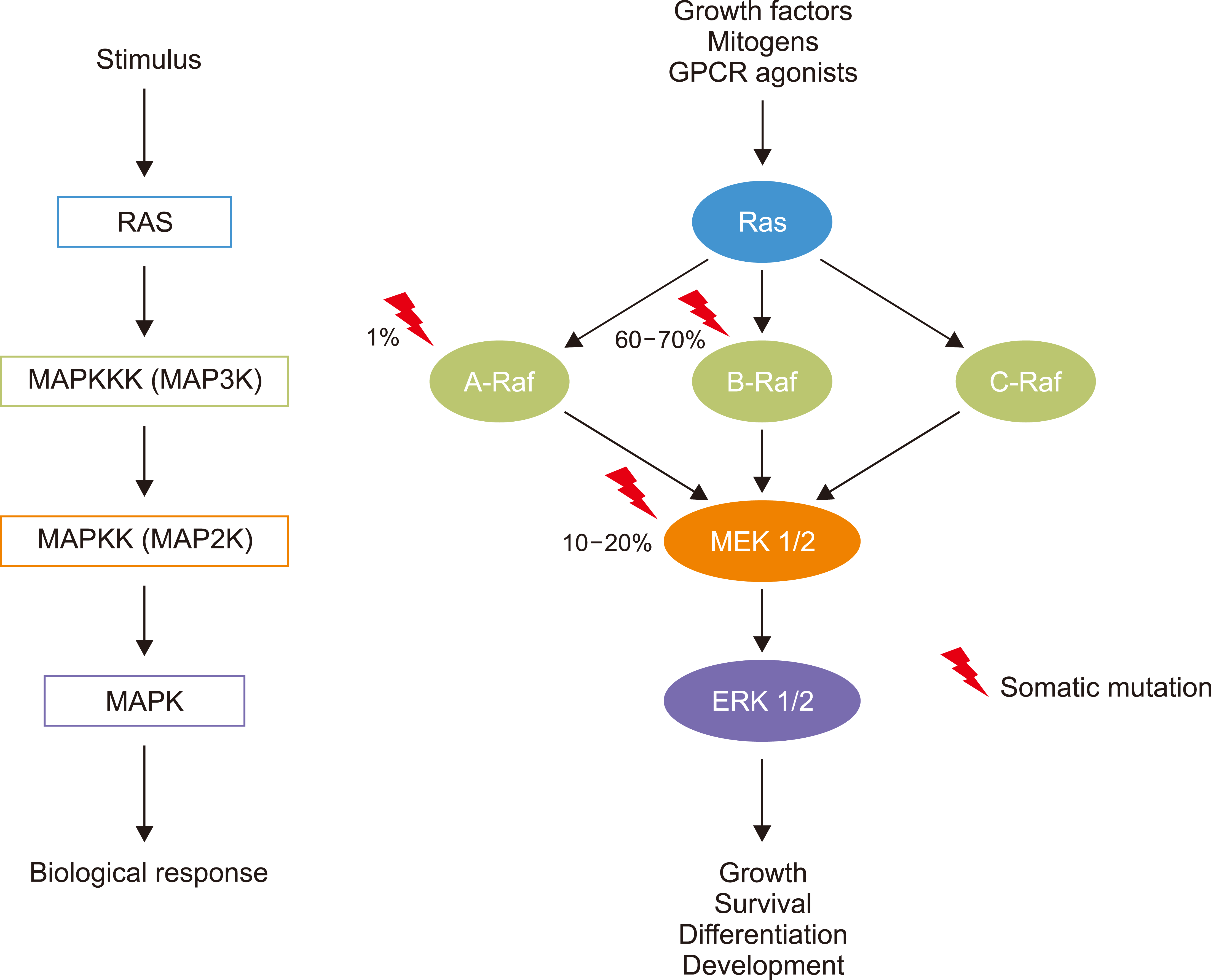1. Héritier S, Emile JF, Hélias-Rodzewicz Z, Donadieu J. 2019; Progress towards molecular-based management of childhood Langerhans cell histiocytosis. Arch Pediatr. 26:301–7. DOI:
10.1016/j.arcped.2019.05.015. PMID:
31281037.


2. Koh KN, Im HJ, Seo JJ. 2015; Recent updates in Langerhans cell histiocytosis. Clin Pediatr Hematol Oncol. 22:15–21. DOI:
10.15264/cpho.2015.22.1.15.

3. Kim BE, Koh KN, Suh JK, et al. 2014; Clinical features and treatment outcomes of Langerhans cell histiocytosis: a nationwide survey from Korea histiocytosis working party. J Pediatr Hematol Oncol. 36:125–33. DOI:
10.1097/MPH.0000000000000054. PMID:
24276037.

4. Berres ML, Merad M, Allen CE. 2015; Progress in understanding the pathogenesis of Langerhans cell histiocytosis: back to Histiocytosis X? Br J Haematol. 169:3–13. DOI:
10.1111/bjh.13247. PMID:
25430560. PMCID:
PMC5193221.


6. Emile JF, Abla O, Fraitag S, et al. 2016; Revised classification of histiocytoses and neoplasms of the macrophage-dendritic cell lineages. Blood. 127:2672–81. DOI:
10.1182/blood-2016-01-690636. PMID:
26966089. PMCID:
PMC5161007.



7. Berres ML, Lim KP, Peters T, et al. 2014; BRAF-V600E expression in precursor versus differentiated dendritic cells defines clinically distinct LCH risk groups. J Exp Med. 211:669–83. DOI:
10.1084/jem.20130977. PMID:
24638167. PMCID:
PMC3978272.



11. Chakraborty R, Hampton OA, Shen X, et al. 2014; Mutually exclusive recurrent somatic mutations in MAP2K1 and BRAF support a central role for ERK activation in LCH pathogenesis. Blood. 124:3007–15. DOI:
10.1182/blood-2014-05-577825. PMID:
25202140. PMCID:
PMC4224195.



12. Sahm F, Capper D, Preusser M, et al. 2012; BRAFV600E mutant protein is expressed in cells of variable maturation in Langerhans cell histiocytosis. Blood. 120:e28–34. DOI:
10.1182/blood-2012-06-429597. PMID:
22859608.

13. Satoh T, Smith A, Sarde A, et al. 2012; B-RAF mutant alleles associated with Langerhans cell histiocytosis, a granulomatous pediatric disease. PLoS One. 7:e33891. DOI:
10.1371/journal.pone.0033891. PMID:
22506009. PMCID:
PMC3323620.

15. Nelson DS, van Halteren A, Quispel WT, et al. 2015; MAP2K1 and MAP3K1 mutations in Langerhans cell histiocytosis. Genes Chromosomes Cancer. 54:361–8. DOI:
10.1002/gcc.22247. PMID:
25899310.

16. Héritier S, Hélias-Rodzewicz Z, Chakraborty R, et al. 2017; New somatic BRAF splicing mutation in Langerhans cell histiocytosis. Mol Cancer. 16:115. DOI:
10.1186/s12943-017-0690-z. PMID:
28679432. PMCID:
PMC5498996.



17. Nelson DS, Quispel W, Badalian-Very G, et al. 2014; Somatic activating ARAF mutations in Langerhans cell histiocytosis. Blood. 123:3152–5. DOI:
10.1182/blood-2013-06-511139. PMID:
24652991.


18. Héritier S, Saffroy R, Radosevic-Robin N, et al. 2015; Common cancer-associated PIK3CA activating mutations rarely occur in Langerhans cell histiocytosis. Blood. 125:2448–9. DOI:
10.1182/blood-2015-01-625491. PMID:
25858893.


20. Haroche J, Cohen-Aubart F, Emile JF, et al. 2013; Dramatic efficacy of vemurafenib in both multisystemic and refractory Erdheim-Chester disease and Langerhans cell histiocytosis harboring the BRAF V600E mutation. Blood. 121:1495–500. DOI:
10.1182/blood-2012-07-446286. PMID:
23258922.


21. Héritier S, Jehanne M, Leverger G, et al. 2015; Vemurafenib use in an infant for high-risk Langerhans cell histiocytosis. JAMA Oncol. 1:836–8. DOI:
10.1001/jamaoncol.2015.0736. PMID:
26180941.


22. Donadieu J, Larabi IA, Tardieu M, et al. 2019; Vemurafenib for refractory multisystem langerhans cell histiocytosis in children: an international observational study. J Clin Oncol. 37:2857–65. DOI:
10.1200/JCO.19.00456. PMID:
31513482. PMCID:
PMC6823889.



23. Heisig A, Sörensen J, Zimmermann SY, et al. 2018; Vemurafenib in Langerhans cell histiocytosis: report of a pediatric patient and review of the literature. Oncotarget. 9:22236–40. DOI:
10.18632/oncotarget.25277. PMID:
29774135. PMCID:
PMC5955145.



24. Kolenová A, Schwentner R, Jug G, et al. 2017; Targeted inhibition of the MAPK pathway: emerging salvage option for progressive life-threatening multisystem LCH. Blood Adv. 1:352–6. DOI:
10.1182/bloodadvances.2016003533. PMID:
29296950. PMCID:
PMC5738993.



25. Hauschild A, Grob JJ, Demidov LV, et al. 2012; Dabrafenib in BRAF-mutated metastatic melanoma: a multicentre, open-label, phase 3 randomised controlled trial. Lancet. 380:358–65. DOI:
10.1016/S0140-6736(12)60868-X. PMID:
22735384.

26. Yang Y, Wang D, Cui L, et al. 2021; Effectiveness and safety of dabrafenib in the treatment of 20 Chinese children with BRAFV600E-mutated Langerhans cell histiocytosis. Cancer Res Treat. 53:261–9. DOI:
10.4143/crt.2020.769. PMID:
32972045. PMCID:
PMC7812025.


27. Karoulia Z, Gavathiotis E, Poulikakos PI. 2017; New perspectives for targeting RAF kinase in human cancer. Nat Rev Cancer. 17:676–91. DOI:
10.1038/nrc.2017.79. PMID:
28984291. PMCID:
PMC6000833.



28. Su F, Viros A, Milagre C, et al. 2012; RAS mutations in cutaneous squamous-cell carcinomas in patients treated with BRAF inhibitors. N Engl J Med. 366:207–15. DOI:
10.1056/NEJMoa1105358. PMID:
22256804. PMCID:
PMC3724537.


29. McClain KL, Picarsic J, Chakraborty R, et al. 2018; CNS Langerhans cell histiocytosis: common hematopoietic origin for LCH-associated neurodegeneration and mass lesions. Cancer. 124:2607–20. DOI:
10.1002/cncr.31348. PMID:
29624648. PMCID:
PMC6289302.



30. Héritier S, Emile JF, Barkaoui MA, et al. 2016; BRAF mutation correlates with high-risk Langerhans cell histiocytosis and increased resistance to first-line therapy. J Clin Oncol. 34:3023–30. DOI:
10.1200/JCO.2015.65.9508. PMID:
27382093. PMCID:
PMC5321082.









 PDF
PDF Citation
Citation Print
Print


 XML Download
XML Download